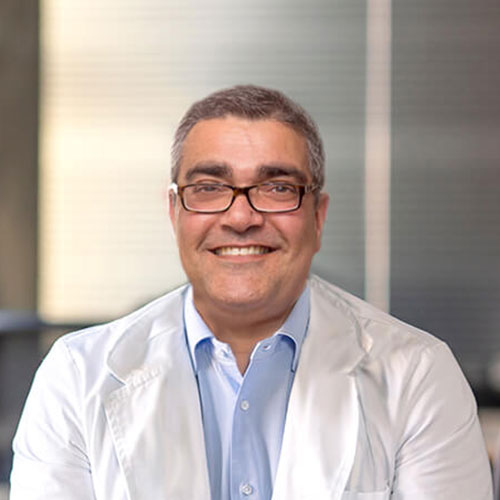In principle, all visits to our private practice for orthopaedics & traumatology in Frankfurt are based on a detailed discussion about the cause, course, treatment options, etc. as well as a thorough physical examination. Only when the patient understands their clinical picture correctly can they support the treatment path with conviction.

Dr. med. Nader Tabrizi
Specialist in orthopaedics and trauma surgery

Dr. med. Stefan Chwalek
Medical practitioner
Sport is known to be the “best medicine”, but various issues can arise. Examples include “tennis elbow”, “runner’s knee” or “fatigue fractures”. These treatments aim to be of the shortest duration possible while maintaining a satisfactory level of sport.
Sports injuries are injuries that you may sustain as a recreational or professional athlete as a result of your sport. There are different types:
- Acute sports injuries
These are caused directly by a specific event such as a fall, a collision or a punch/kick. - Chronic sports injuries
They develop slowly and insidiously (e.g. due to permanent overloading). Chronic injuries last a long time and are sometimes difficult or even impossible to heal. - Endogenous sports injuries
Injuries of this kind are sustained by sportsmen and sportswomen without any external influence, for example as a result of faulty training or overexertion in competition. They can be acute or chronic. - Exogenous sports injuries
An exogenous injury involves another person. It occurs, for example, during a sporting confrontation or a duel.
Typical sports injuries are strains, contusions, sprains and fractures. However, injuries to muscles (e.g. muscle fibre tears), tendons and ligaments are also common. Dislocations are also among the most common sports injuries. Depending on the injury, there is (severe) pain, bruising and swelling. In most cases, the ability to move is also restricted or even completely prevented.
If you have acute complaints, but also for preventive care, our private practice for orthopaedics and traumatology is the right place for you.
During the sports medical examination, we pay special attention to your sport-specific stress tolerance. We check whether you already have overuse injuries or are at risk of them. This includes, for example, the condition of your joints, including capsules, ligaments and tendons, as well as the function of your muscles. With the sports medical examination, we can identify any existing risk factors at an early stage and initiate treatment measures as they arise. In this way, we can avoid permanent and consequential damage at best.
Typical diagnostic measures in sports medicine include physical examination/tactile examination and imaging measures such as X-ray, CT and MRI. Ultrasound and blood tests are also possible. In some cases, we also use fitness equipment such as a treadmill or bicycle ergometer for sports medicine examinations. This allows us to determine and monitor your physical performance.
For many acute sports injuries, it makes sense to follow the so-called PECH rule. According to this, you should first take a break from your sport and take it easy on the affected body part. In addition, it can be beneficial to cool the injury, apply a pressure bandage and elevate it. This will minimise the pain and swelling. In short: Pausieren (rest) – Eis (ice) – Compression – Hochlagern (elevation).
With painkillers, rubbing with pain gels, ointments or sprays and arnica, and following the PECH rule, bruises, sprains, strains and torn muscle fibres usually heal on their own. They just need time. Sometimes splints can be useful as joint support. Torn ligaments can also often be treated conservatively with painkillers, bandages or tape dressings plus rest. Surgery is only necessary for certain types of ligaments and for concomitant injuries to the bone. In the case of bone fractures, the therapy generally consists of fixing the fracture pieces in their normal position (e.g. with a plaster cast) until the fracture has healed. Surgery is often necessary for more complicated fractures.

